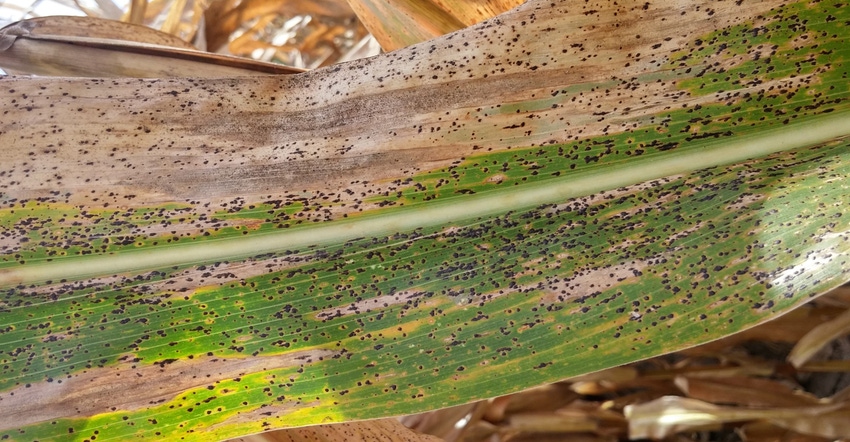
Corn growers need to get out the magnifying lens this year and look for small black spots on corn leaves. Tar spot is a disease that has infiltrated cornfields across the Midwest and is spreading into Missouri.
Farmers first reported tar spot in the state in 2019. Marion County in northeast Missouri is a hot spot for the corn disease and sees the highest incidences of the fungal pathogen, says Kaitlyn Bissonnette, University of Missouri Extension plant pathologist.
This disease can spread quickly, with nine counties in the state having confirmed tar spot in two years. “That is how explosive this disease can become,” she says.
Missouri is not alone in fighting the disease. Farmers across Indiana, Illinois, Iowa and up through Michigan and Wisconsin have been battling tar spot since 2015. The disease can cause devastating yield loss of up to 40% of a field. “It’s bushels, upon bushels, upon bushels,” Bissonnette says. “We don’t want to get to that level in Missouri.”
Conditions right for tar spot
Bissonnette shared a tar spot update during the 2021 University of Missouri Crop Management Conference.
The disease likes moderate temperatures, relative humidity at greater than 75%, an average of seven hours per night of leaf wetness, 10 to 20 days of foggy weather per month, and monthly rainfall totals of 5.9 inches.
“Not every single one of these characteristics has to be exactly true,” Bissonnette explains, “but the biggest driving factor is leaf wetness at night.”
Based on these conditions, much of the northern half of the state falls in the higher-risk area, with the middle portion of the state facing moderate risk. However, Bissonnette points out that tar spot development in Georgia and Kentucky in 2021 increases the risk in the Bootheel and the southern region of the state for 2022.
Recognize tar spot in the field
True to its namesake, this pathogen appears as small black spots — circular or oval in shape — resembling tar on a corn plant. They are raised off the leaf surface.
Tar spot can occur any place on the plant canopy. “If you're in a field where you've had a history of tar spot, a lot of times, it'll start in the lower plant canopy,” Bissonnette explains. “But if you're a field where you've never seen it, it might begin in the middle of the canopy. It could be in the lower canopy. Really, it can be anywhere.” And the disease can present as a single spot on a single leaf or multiple spots on leaves.
Occasionally, the black tar spots have a brown halo surrounding them. To farmers, it may appear like a fish-eye-looking lesion or almost like it is bleached out around the black spot.
Tar spot can resemble insect frass, so it's important to try and scrape the black spot away or wash it away. “If it comes off, it's not tar spot,” Bissonnette says. “If your fingers are orange or a black color, that's not going to be tar spot.”
Identifying tar spot from southern rust late in the growing season can be complicated. Southern rust also turns a dark color, almost black in appearance. However, southern rust breaks through the leaf surface.
“Unlike other diseases, the actual tar spot lesions, the stroma, have not broken through the leaf surface,” Bissonnette explains. “This is going to be really important because it's going to be different than other diseases you might see in the field around the same time of year.”
Farmers should scout in early to mid-August. However, last year, fields in the northeast region of the state started seeing the disease in early July. Therefore, if tar spot has been detected, farmers should start scouting earlier in areas where the disease has previously been detected.
Bissonnette recommends farmers carry a magnifying lens when scouting to look closely and see if the cells have broken through the leaf surface. And while a visual assessment is good, testing the sample in the lab provides definitive results and can differentiate tar spot from other diseases. Knowing what type of disease is present will help with management options
Management options
With tar spot being a relatively new disease in the U.S., it needs further study to find the most effective crop management tools to stop the spread. However, here are a few options growers may consider:
Fungicide application. Tar spot is a fungal pathogen, not a bacteria or virus. In preliminary trials, several fungicides show they may reduce tar spot when applied at the tasseling (VT) through brown silk (R2) growth stages. Remember, this is a late-season disease, so timing of application is important. Early fungicide applications will likely not protect from tar spot.
Mitigate infected residue. This is an airborne and residue-borne pathogen. It starts with already infected debris at the surface, which leads to infected corn. The debris can be blown into an area from a neighboring field increasing the spread. Consider crop rotation and tillage the following year in those fields previously infected to reduce survival. Unfortunately, the amount of time a previously affected field must be rotated away from corn is still unknown.
Limit water use. Irrigation management is important in reducing the spread of tar spot as leaf wetness is known to promote the disease. Offsetting irrigation timing with fungicide application can help control the spread of tar spot based on research from Michigan State University.
Hybrid selection. The most popular and effective tool for managing tar spot is to plant hybrids with resistance to the disease. However, there is a difference among hybrids regarding resistance and susceptibility to tar spot. States such as Indiana found hybrids susceptible to tar spot infection, but the disease severity, the formation of halos or fish-eyes, and plant senescence varied greatly.
About the Author(s)
You May Also Like






